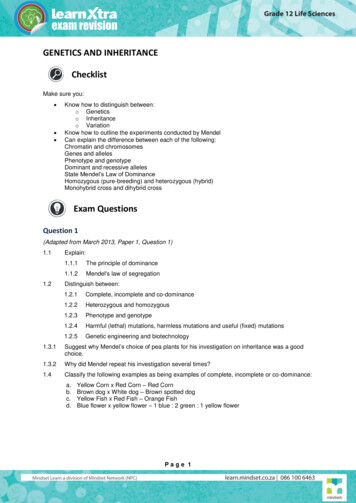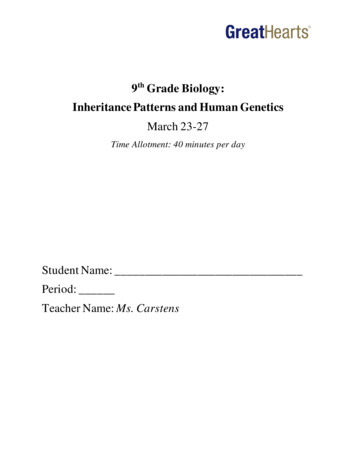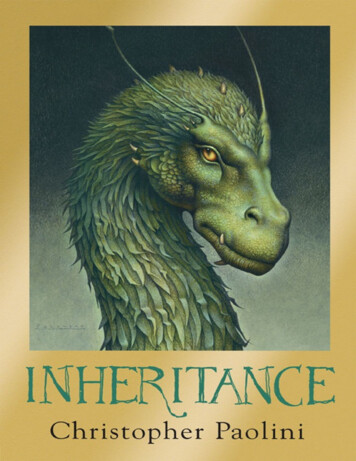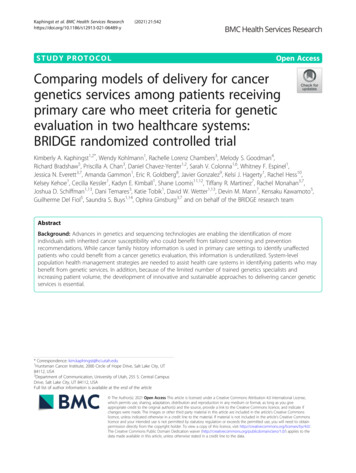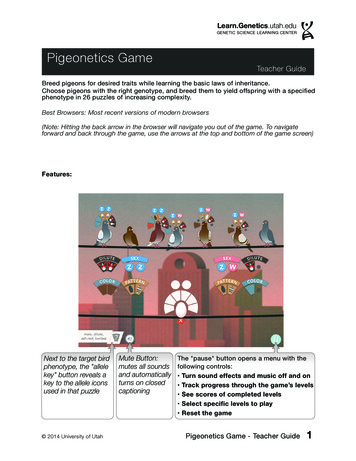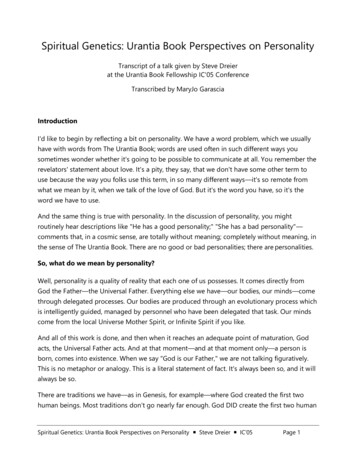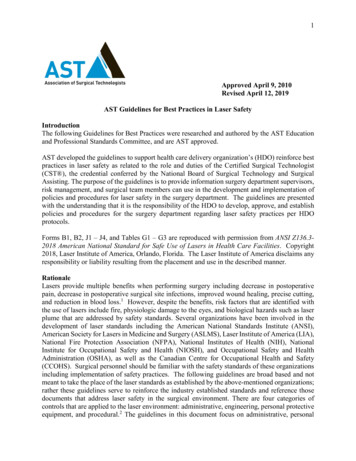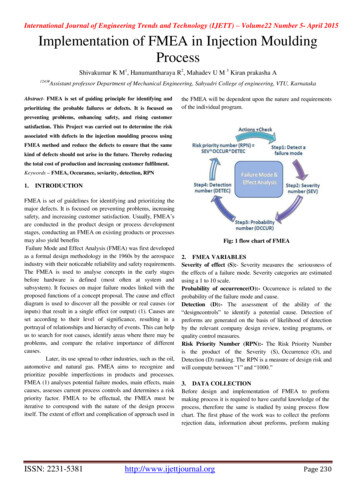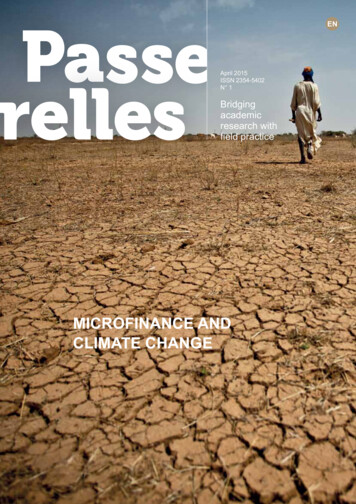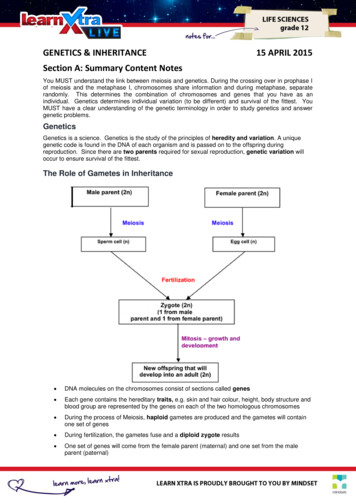
Transcription
GENETICS & INHERITANCE15 APRIL 2015Section A: Summary Content NotesYou MUST understand the link between meiosis and genetics. During the crossing over in prophase Iof meiosis and the metaphase I, chromosomes share information and during metaphase, separaterandomly. This determines the combination of chromosomes and genes that you have as anindividual. Genetics determines individual variation (to be different) and survival of the fittest. YouMUST have a clear understanding of the genetic terminology in order to study genetics and answergenetic problems.GeneticsGenetics is a science. Genetics is the study of the principles of heredity and variation. A uniquegenetic code is found in the DNA of each organism and is passed on to the offspring duringreproduction. Since there are two parents required for sexual reproduction, genetic variation willoccur to ensure survival of the fittest.The Role of Gametes in Inheritance DNA molecules on the chromosomes consist of sections called genes Each gene contains the hereditary traits, e.g. skin and hair colour, height, body structure andblood group are represented by the genes on each of the two homologous chromosomes During the process of Meiosis, haploid gametes are produced and the gametes will containone set of genes During fertilization, the gametes fuse and a diploid zygote results One set of genes will come from the female parent (maternal) and one set from the maleparent (paternal)
The two sets of genes may be the same or different for a trait, e.g. the mother may havegenes for black hair and the father may genes for have blonde hair The offspring inherits two sets of genes, 50% from the mother and 50% from the father andmay therefore be different from each of the parents The diploid zygote therefore contains a double set of DNA and is a combination of bothparentsGenetic terminologyGenetics is a science and specific terms are used. Make sure that you know and understand thefollowing terms very well as they form the basis for ALL the genetics that you will study. Locus: This is the exact position or location of a gene on a chromosome. Alleles: Alternate forms of a gene that are located at the same point on each of the twohomologous chromosomes and represent a specific trait – one from the father and onefrom the mother. Homozygous:Homo same and zygous zygote. When two alleles of anagene are thesame for one trait e.g.: both alleles are for red flowers, the cross will result in a pure breedfor red. Heterozygous: Hetero different and zygous zygote. When two alleles of a gene aredifferent for a trait e.g.: one of the alleles is for red flowers and one is for white flowers, thecross will result in a mixture of the two genes called a hybrid. Dominant trait: A heterozygous offspring will display the dominant trait because it willdominate over the other recessive gene of the allele pair, e.g.: red colour will dominate overthe gene for white colour, so the offspring will look red. The dominant allele is always written with a capital letter: R red and the recessive iswritten in lower case r white.o Homozygous dominant alleles means that both genes are the same for the samedominant trait. It will be represented by RR, which represents both the genes for redflowers. The offspring will be red because two dominant genes are present.o Heterozygous alleles means that one gene is dominant and one gene isrecessive for the same trait, e.g. red flowers. It will be represented by Rr, whichrepresents one gene for red and one gene for white. The offspring will display redflowers, because red is dominant over white.Homozygous dominantHomozygous recessiveRR (Red colour)rr (White colour)(pure red)(pure white)Heterozygous dominantRr (Red colour)(red) Recessive trait: The recessive allele is the trait that is dominated over by the dominant gene.It is written with a small letter: r white.Homozygous recessive alleles means that both recessive genes are the same, i.e.: rr – twogenes for are present for white flowers. The offspring will display the recessive white colouronly. The recessive trait will only ever be seen when it is in the homologous state.
Complete dominance: the type of dominance where the dominant allele completely masks therecessive allele. Even when the recessive allele is present in a heterozygote, it is notdemonstrated.Codominance: the type of dominance where both alleles in a gene pair are expressed fully. Anexample is human blood groupings.Incomplete dominance: when the dominant gene allele is not able to completely dominate overthe recessive gene allele, a mix of the two genes results, e.g.: red white pink. When theoffspring is heterozygous with incomplete dominance, you will be able to see the combination ofthe two gene alleles traits:Homozygous dominantHomozygous recessiveRR (RED Colour)rr (white colour)(pure red)(pure white)Heterozygous incompletedominanceRr (Pink colour)(pink) Genotype: This is the genetic composition of an organism and represents the information that ispresent in the gene alleles, for example RR, Rr, rr. You cannot see this because it is in thegenes. Phenotype: This is the physical appearance of an individual, i.e.: what you will see when youlook at the offspring. The phenotype is determined by the genotype. You will see white flowersfor rr, but you will see red flowers if the genotype is RR or Rr. Monohybrid cross: Mono ONE so, when one pair of contrasting traits is crossed to determinethe possible inheritance of the offspring. There will be 4 possible combinations that result from thecross – 2 possibilities from the male and 2 possibilities from the female (2 x 2 4). Dihybrid cross: Di TWO, so when two pairs of contrasting traits are crossed to determine thepossible inheritance of the offspring. There will be 16 possible combinations that result from thecross – 2 possibilities from the male and 4 possibilities from the female (4 x 4 16).Filial generation: The parents are represented by P1. The parents reproduce to produceoffspring that result from the cross. The offspring are the first filial generation and this isrepresented by F1. When the offspring become mature and reproduce, they are represented byP2. Their offspring will be the second filial generation represented by F2. Punnet square: This is a schematic representation of a cross. Take careful note of the way theinformation is written.Mendel’s Laws:Background:Gregor Mendel (1822–1884) was an Austrian Augustinianmonk who enjoyed experimenting withplants and investigating the outcome. He is known as the first biogeneticist. He studied thecharacteristics of garden peas grown in the monastery garden and recorded his findings. The laws hewrote are based on these findings and are used by geneticists today.Mendel’s first law:The Law Segregation:During gamete formation each member of the allelic pair separates from the other member to form thegenetic makeup of the gamete. When two individuals with contrasting homozygous (pure-bred)characteristics are crossed, the individuals of the F1 hybrid generation will all resemble the parentpossessing the dominant characteristic. This law shows the principles of dominance and
recessiveness using the characteristic of height. Pea plants either grow tall (TT or Tt) or are shortplants (tt). Mendel crossed the pure bred homozygous tall and homozygous short varieties to provehis theories.P1/parentphenotypegenotypeFather purebred tallTTxxT, ther purebred shortttt, tF1/offspringGenotype:100% TtPhenotype:100% Tall(Note that the F1 offspring show characteristics from both parents.)The plants of the F1 grow and mature. When they are ready to reproduce, they produce gametes fortallness (T) and shortness (t) because the gametes segregate (T T t t) during meiosis. Onehalf of the gametes will contain the characteristic of one of the parents - for tallness and the other halfwill contain the characteristic of the other parent plant - for shortness. The characteristic for shortnessis the recessive characteristic and it will appear in the second cross offspring called the F2generation.P2/parentheterozygous tall motherGenotypeMeiosisGametesPhenotypeheterozygous tall father xTtxTtT, txT, ype:Phenotype:25% TT, 50% Tt, 25% tt75% tall25% shortSection B: Exam practice questionsQuestion 1In horses black coat colour (B) is dominant over white (b). A white mare mates twicewith the sameblack stallion. She produces a white foal on the first occasion and a black foal on the secondoccasion. Use the letters B and b as indicated above and write down the genotypes of:1.1.the mare and stallion(2)1.2.the first and second foal(4)
Question 2In guinea-pigs, the gene for black coat is dominant to the gene for white. Two heterozygous blackguinea-pigs are crossed.2.1.By means of a diagram, show the genotypic results that would be expected in theF1 generation.2.2.(6)One of the white F1 offspring was crossed with its black parent. By means of a diagram showthe expected F1 genotypic results of this new cross.(6)Question 3Fur colour in mice is controlled by a gene with two alleles. A homozygous mouse with black fur wascrossed with a homozygous mouse with brown fur. All the offspring had black fur.Using the symbols B and b to represent the two alleles for fur colour, show as a punnet square, agenetic cross between a mouse that is heterozygous for fur colour with a mouse with brown fur.Show the possible genotypes and phenotypes of the offspring.(6)Section C: SolutionsQuestion 11.1.Mare is bb x stallion Bb (if the stallion were BB, then they would not be able to produce awhite foal).(2)1.2.The genotypes of the foals will either be Bb or bb (4)Question 22.1.Black BWhite bP1 PhenotypeBlack furGenotypexBb x Bbblack fur-Meiosis FertilisationGametesBbBBBBbbBbbbF1Genotype:1/4 BB , 2/4 Bb ,1/4 bbPhenotype:75% black25% white(6)
2.2.P1/ parent Phenotypeblack furxGenotypeBbxbb -MeiosisGametes white fur B,bxb,bFertilisationGametesBB BBbBbbbbbbF1Genotype:50% Bb , 50% bb Phenotype:75% black, 25% white (6)Question 3P1phenotypeBlack x Brown genotypeBb x bb gametes bMeiosisGB, bx bFertilisationF1bBBb BbbbbbbORgenotype Bbandbb 1 mark for correct gametes1 mark for correct genotypesphenotype Black and brown 1 mark for stating P1 AND F1 (must have both)1 mark for stating meiosis AND fertilisation (must have both)(Any 6)[6]
GENETICS & INHERITANCE 15 APRIL 2015 Section A: Summary Content Notes You MUST understand the link between meiosis and genetics. During the crossing over in prophase I of meiosis and the metaphase I, chromosomes share information and during metaphase, separate randomly. This determines the combination of chromosomes and genes that you have as an individual. Genetics
